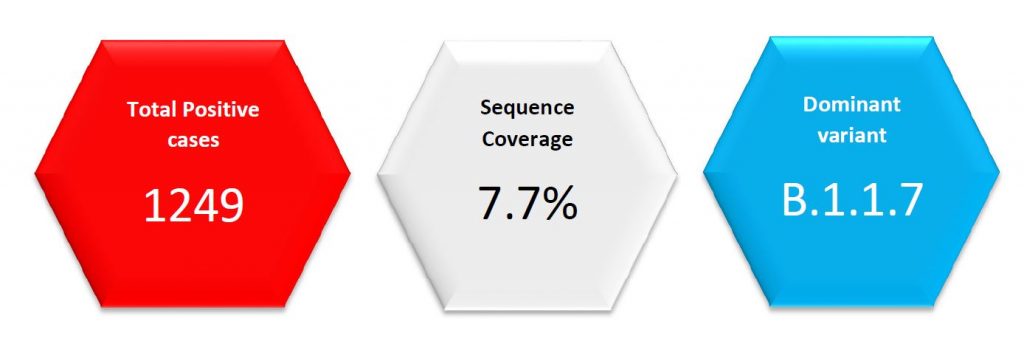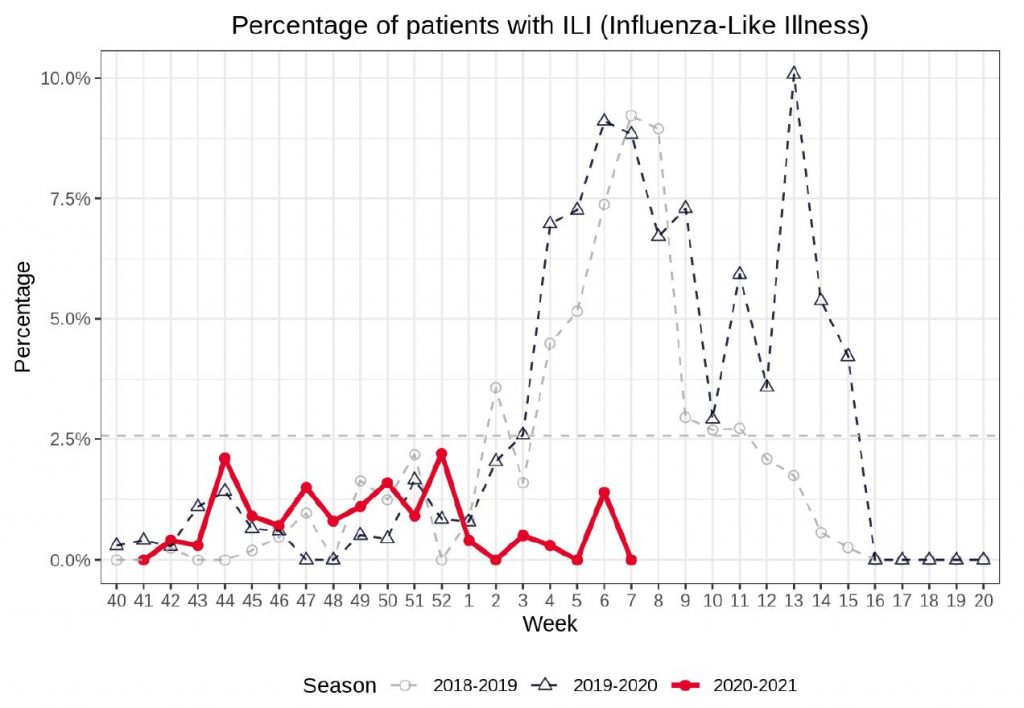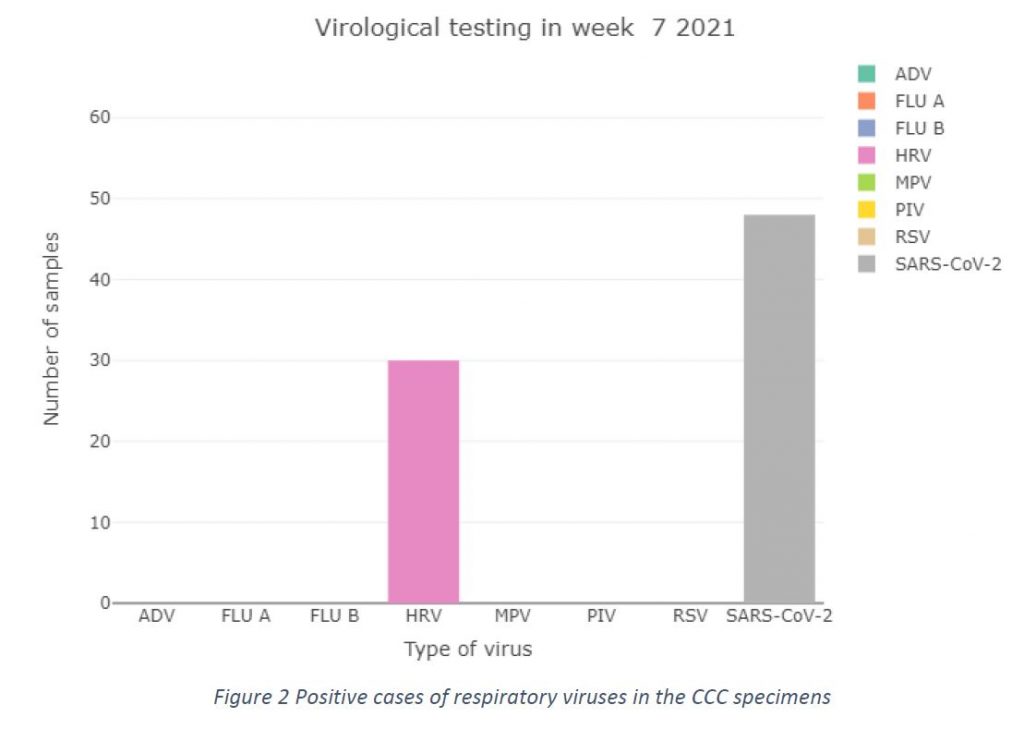
The aim of the “Sentinel” national surveillance program is to monitor the circulating respiratory viruses, including SARS-CoV-2 variants, and hence underpin public health actions.
In Week 7/2021, the overall frequency of the SARS-CoV-2 B.1.1.7 variant in all samples sequenced remained stable at 53%. After excluding specimens obtained via target sequencing, the prevalence of the B.1.1.7 variant, in the non-targeted sequencing sample, was 56% and comparable to last week’s prevalence. For the SARS-CoV-2 B.1.351 variant, we found an overall frequency of 22.7% within the sequenced samples. However, as 8 cases were from non-residents, the corrected frequency in all sequenced samples was 15.9%.
The total number of sequences performed this week was 272, with only 97 samples sequenced for the time frame of week 7/2021. The sequencing coverage dropped this week to 7,77% from all positive cases in Luxembourg, while the newly sequenced specimens had improved the sequencing coverage in week 5/2021 (39.6%) and week 6/2021 (22.2%). Therefore, this week’s sequencing coverage cannot be considered as representative of the general population.

At present, the scope of the ReViLux report is to provide (i) surveillance and descriptive epidemiology data, including data on molecular phylogenies (identification of importation events, changes in outbreak size over time), and (ii) phylogenetic interpretation of regional virus spread and circulation in Luxembourg, and cluster investigation. The scope of the ReViLux report is not to attempt phylogeographical reconstructions in Luxembourg, as a whole.
The “Sentinel” surveillance network is composed of 37 general practicioners and paediatricians around Luxembourg (General Practice and Paediatrics). The “Sentinel” surveillance network reported 133 consultations in week 7 (15/2/2021 – 22/2/2021). There were no cases of ILI1, representing 0% of consultations (epidemiological threshold is 2 new cases per week), as shown in Figure 1. The percentage of consultations for ARI2 was 12%.

Figure 1 Percentage of patients with ILI over the epidemiological surveillance weeks
Patients presenting with ILI and ARI at the Covid Consultation Centre (CCC) in Luxembourg were tested using a respiratory virus panel (ADV = Adenovirus, FLU A = Influenza A, FLU B = Influenza B, HRV = Human Rhinovirus, MPV = Human metapneumovirus, PIV = Parainfluenza virus, RSV = Respiratory Syncytial Virus, SARS-CoV-2 = Severe acute respiratory syndrome coronavirus 2). The SAR-COV-2 was the most prevalent respiratopry virus detected in the “Sentinel” network, with 48 positive cases (25.3%). The wave of Human Rhinovirus (HRV), circulating currently in Luxembourg, continued in week 7/2021, with 30 positive cases in 183 tests (15.8%). No cases of Influenza A/B were detected, indicating absence of circulation of Influenza viruses in Luxembourg, as shown in Figure 2.
In Luxembourg, we have tested 190 samples from the Sentinel surveillance network, as compared to 996 samples tested in Europe, in the week 07/2021. Two of these 996 specimens tested for influenza viruses were positive. The influenza epidemic in the European Region has usually reached its peak by this point of the year but, despite widespread and regular testing for influenza, reported influenza activity still remains at a very low level, likely due to the impact of the various public health and social measures, implemented to reduce transmission of SARS-CoV-2 (Source: FluNews Europe).

The National Reference Laboratory for Acute Respiratory Infections at LNS strives to achieve representativeness of the pool of sequenced specimens to reach real-time epidemiology, by implementing the following weekly sequencing activities:
A representative sequencing sample calculation was based on the minimum number of specimens required to extrapolate prevalence of VOC variants with error rate of 5%. Based on the total number of positive specimens during the period 01-21/FEB/2021 (3443) , and their geographic distribution across Luxembourg, we concluded on the minimum number of specimens per each canton, as shown in Figure 3. An average sequencage coverage of 11% is the minimum coverage to allow extrapolation of frequencies of variants with confidence.
The starting material used for sequencing is respiratory specimens (nasopharyngeal or oropharyngeal swabs) that have already been tested positive by RT PCR.
The LNS sequencing data sharing strategy includes sharing of the sequencing data with GSAID EpiCov database (www.gsaid.org ) on a periodic basis.

Last week the microbial genomics platform at the LNS sequenced 272 specimens. Out of these, 97 specimens were collected in week 7/2021. This represents 7.77% of new infections reported in Luxembourg in week 7/2021. Among the 97 specimens, 16% (15 samples) corresponded to targeted specimens (contact tracing with 14 specimens and cluster investigation with 1 specimen).
The population sequencing coverage in week 7/2021 was 6,57%. This is below the estimated coverage of 11% being the minimum requirement for a representative population sequencing sample. Based on statistical inference, the frequency of the reported variants in Week 7/2021 is not representative of the circulating variants in Luxembourg.
Lineages (variants) have been assigned based on Rambaut et al by means of Phylogenetic Assignment of Named Global Outbeak LINeages (pangolin) software (v2.3, pangoLEARN version 2021-02-18).
The lineage nomenclature system that we use is the one proposed by Rambaut et al. that focuses on actively circulating virus lineages (https://cov-lineages.org ).
In the sampling period of week 7/2021, 11 circulating SARS-CoV-2 variants were detected within our sequencing pool, as shown in Figure 3. The most prevalent lineage was B.1.1.7 (52.6%), followed by B.1.351 (22.7%) and B.1.160 (12.4%). However, the number of local cases of B.1.351 variant was corrected to be 14 only, with 6 cases originating from France and 2 cases from Belgium.

Among specimens collected within the week 7/2021, 51 cases of the B.1.1.7 variant have been detected, representing 52,6% of the specimens in the week’s sequencing pool (by comparison, the week 6/2021 pool, which also included specimens from previous weeks’ collections, had shown 54,1% of this variant). The total case count of sequenced variant B.1.1.7 was 543 by week 7/2021. The earliest collection date for this variant remains 19/DEC/2020 and the latest is 19/FEB/2021.
In the collection period of week 7/2021, 22 cases of the South African variant B.1.351 have been detected, representing 22,7% of the specimens in the week’s sequencing pool (by comparison, the week 6/2021 pool, which also included specimens from previous weeks’ collections, had shown 10,7% of this variant). The total case count of sequenced variant B.1.351 was 83 by week 7/2021. The earliest collection date for this variant remains 11/JAN/2021 and the latest is 19/FEB/2021.
In week 7/2021, no cases of the Brazilian variant P.1 were detected, therefore the total case count of variant P.1 was 1 by week 7/2021 (collection date 02/FEB/2021). Last week, the pangolin group, which provides a global report on novel coronavirus haplotypes, published two additional variants of concern, assigned as A.23.1 and B.1.525. Both variants have already been reported by neighboring countries (Belgium, France). However, none of these variants has been detected in Luxembourg.
Lineage B.1.1.7 is characterized by several spike protein mutations, including N501Y, H69/V70del and P861H. The variant seems to have a considerable epidemiological impact, as it has a higher transmissibility rate.
Lineage B.1.351 holds numerous spike protein mutations, of which three are located in the receptor binding domain (K417N, E484K and N501Y), and are therefore relevant for antibody binding. As for B.1.1.7, a higher transmissibility rate and viral loads seem to be associated with this variant. Due to the K417N and E484K mutations, an impact on vaccination efficacy and possibility of reinfection is subject to scientific investigation.
Lineage P.1 (descendent of B.1.1.28), initially found in the Amazon region, has a similar mutation profile as the South African variant, including E484K and N501Y. Concerns are, as for the South African variant, higher transmissibility and a decreased protection by neutralizing antibodies.
Of note, additional specimens are in the pipeline for sequencing, so that numbers may change with increasing representativeness of circulating variants and proportions.

Phylogenetic analysis is done by means of Nextstrain (https://nextstrain.org/sars-cov-2/) and is based on genetic distances including a timeline on the x-axis. The phylogenetic tree is rooted against the first sequence obtained in Luxembourg (29/FEB/2020), which is considered as our “outgroup”. Sequences obtained before 01/NOV/2020 are shown as grey dots. Sequences obtained within the last 2 weeks, are represented in colour and by greater dot diameter. In the context of increasing numbers of sequences, a random subsampling of 300 sequences over the whole sequencing period, starting 01/SEP/2020, was performed.
The phylogenetic tree shows four visually well separated clusters. These clusters correspond to the lineages B.1.160, B.1.177, B.1.1.7 and B.1.221. Due to random selection of sequences and the intentional insertion of variants of concern, the cluster representation is mostly qualitative and does not necessarily correlate with relative prevalence of the respective variants (Figure 5).
Lineage B.1.1.7 (represented by light brownish dots) forms a well distinguishable cluster, due to the high number of accumulated mutations. B.1.1.7 subtrees might indicate different subgroups, possibly related to different routes of infection.

Currently the LNS genomic surveillance program – independently from lineage calling – notes the occurrence of 13 different known SARS-CoV-2 mutations, assumed to have clinical and epidemiological relevance. The list of observed mutations is being updated continually, based on the appearance and prevalence of SARS-CoV-2 variants.
The following table provides the overall frequencies of these mutations, detected in the lineage-assignable genome sequences, analyzed between 01/SEP/2020 and 19/FEB/2021 (N=4665), as well as the frequencies in week 7/2021.

The ReViLux data are communicated as support to the understanding of respiratory virus transmission dynamics, including introduction of new variants, to the evaluation of the impact of response measures, to the contact tracing and the investigation of clusters.
Genomic sequencing of SARS-CoV-2. A guide to implementation for maximum impact on public health. WHO, 8 January 2021.
COVID-19 data portal. 2020 (https://www.covid19dataportal.org/sequences )
J Hadfield et al. Nextstrain: real-time tracking of pathogen evolution. Bioinformatics 2018;34:4121-4123
A Rambaut et al. A dynamic nomenclature proposal for SARS-CoV-2 lineages to assist genomic epidemiology. Nat Microbiol 2020;5:1403-1407
https://github.com/cov-lineages/pangolin
Y Guangchuang et al. ggtree: an R package for visualization and annotation of phylogenetic trees with their covariates and other associated data. Methods in Ecology and Evolution 2017;8:28-36
For more information on lineages visit: https://cov-lineages.org
For more information and statistics on Covid-19 infections in Luxembourg visit: https://covid19.public.lu/en.html